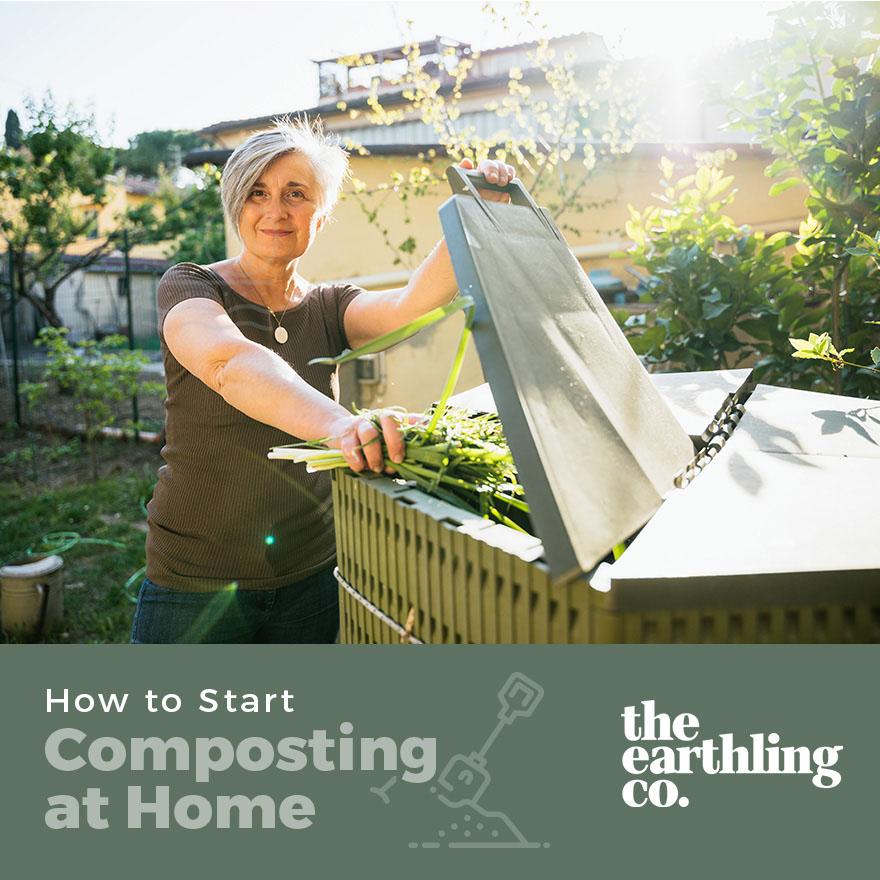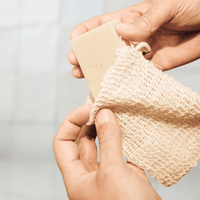
What’s not to love about composting? It’s easy to do and a great way to use organic waste — like food scraps, yard trimmings, shredded paper and other things — that would otherwise go to a landfill and contribute to methane gas emissions. And on top of all that, compost is an excellent material for garden soil. (They don’t call it “black gold” for nothing!)
If you’ve ever wanted to know how to start composting at home, but didn’t know where to begin, you’ve come to the right place. Read on to learn about the basics of composting and easy ways to get started.
What Is Composting?
In a nutshell, composting is a natural process by which organic materials (like egg shells, banana peels, and potato skins) are broken down by bacteria and fungus in the soil. The result is a nutrient-rich, dark substance called compost.
All things decompose eventually. With composting, you’re simply speeding up the process by creating the ideal environment for microbes to thrive.

How Is Compost Made?
To make healthy compost, you need these basic ingredients:
- Browns: “Browns” refers to twigs, dead leaves, paper and other carbon-rich materials that help attract microbes to your compost pile.
- Greens: “Greens” refers to materials that are nitrogen-rich. This includes materials such as grass clippings, plant clippings and most kitchen scraps.
- Air: Composting is an aerobic process, which means that it needs air to decompose properly. If you don’t introduce enough oxygen into your compost pile, it can become anaerobic (meaning, without oxygen), which leads to a smelly and inefficient compost pile.
- Water: Finally, your compost needs moisture. Water helps with breaking down your browns and greens, as well as regulating the temperature of your compost pile.
Benefits of Composting
Whether you’re an environmentalist, an avid gardener or just someone who wants a better-smelling trash, there’s a lot to love about composting. Here are a few ways in which composting is beneficial for the environment and your wallet.
- Improves Soil Health – Gardeners, farmers and landscapers have long been using compost as a way to create healthy, nutrient-rich soil for growing seasons. Unlike chemical fertilizer, compost delivers a slow release of nutrients that is less likely to damage your plants. Additionally, compost helps the soil absorb and retain nutrients and water, which means less watering and greater protection against diseases and pests.
- Reduces Food Waste – Once you start composting at home, chances are you’ll develop a newfound appreciation for your food. Composting makes you more conscious about how much food you’re throwing away every day, where your food came from and the processes it may have gone through before it reached your kitchen table. In this way, it can encourage you to make more sustainable changes — like using silicone bowl covers to keep your food fresher for longer and freezing your leftovers before they spoil.
![]()
- Lowers Methane Gas Emissions from Landfills – Did you know that an estimated 17 percent of U.S. greenhouse gas emissions come from landfills? Since landfills are often tightly packed, there simply isn’t enough oxygen for organic waste to break down naturally. Instead, these organic materials break down anaerobically and produce methane. By composting at home, we can divert waste from landfills and create more space for landfill waste to break down effectively.
- Puts Carbon Back in the Ground – On top of decreasing methane gas emissions from landfills, compost can also help reduce carbon dioxide emissions by taking carbon from the air and putting it back into the ground. Compost enhances the growth of plants and protects them from diseases, allowing them to grow larger and pull more CO2 from the air.

Basic Rules of Composting
The beauty of composting is that anyone can do it, regardless of space or budget. There is a composting system out there for everyone, so don’t let something like a small apartment or a lack of special equipment hold you back!
The downside to this, as a beginner, is that it’s easy to get overwhelmed and confused. Which leads us to our first rule…
1. Don’t Overthink It
All you’re doing is controlling decay, a process that happens in nature all the time. So unless you’re a farmer relying on compost to produce a healthy harvest for their family, don’t stress too much about your mistakes. Your compost pile will almost certainly recover from them. If you have too many browns, just add more greens. If your pile is too wet, add some dry ingredients and let it air out. You get the picture.
2. Stay Away from Animal Products
Most organic materials can be composted, but not all of them should go in your compost pile. Animal products such as meat scraps and bones can attract unwanted pests and create odor problems. Dog and cat feces, along with cat litter, can transmit harmful pathogens.
For this reason, beginner composters should avoid adding animal products to their first compost pile.
3. Go Beyond Kitchen Scraps
On the flip side, don’t be afraid to look beyond kitchen scraps for compost ingredients. There are tons of non-food items that you can compost in your kitchen, including cotton mesh produce bags, empty cereal boxes (minus the plastic), napkins, paper towels, coffee liners and greasy pizza boxes.
Do you use our wooden dish scrubber to get your dishes clean? It’s compostable, too! After your dish scrubber wears down, simply toss it into your compost pile and let the microbes in the soil work their magic.

Don’t forget: There are also plenty of sources of organic materials outside of the kitchen that would be a welcome addition to your compost pile. Take your bathroom, for example. You can compost all sorts of bathroom items, including:
- Toilet roll tubes
- Cotton ear buds
- Used tissues
- The handle of a bamboo toothbrush
- Old washcloths
- Reusable cotton rounds at the end of their life

4. Strike the Right Carbon-to-Nitrogen Ratio
If you’ve done any advanced research on composting, then you probably know that getting the right mix of carbon (browns) and nitrogen (greens) is important. This concept is key to any successful compost pile because the right carbon-to-nitrogen ratio will break down your ingredients fast with minimal smells and problems.
Again, most compost problems can be fixed with minor adjustments (e.g., adding more greens or browns), so don’t stress too much about getting ratios perfect in the beginning. To start, aim for two parts brown to one part green and adjust as needed.
Here are a couple of principles to keep in mind:
- If your materials aren’t breaking down, you probably have too many browns.
- If your compost is smelly or moldy, you may have too many greens.
5. Don’t Forget Air and Water
Remember that methane forms under anaerobic (zero oxygen) conditions, which is one of the many reasons why our ever-growing landfills are bad for the environment. To avoid producing methane while composting at home, you need to regularly introduce oxygen to your compost pile. There are many ways to do this, but one of the simplest is by taking your shovel and turning your pile every few days.
On a similar note, your compost pile also needs water. Your pile should be moist — not wet or soggy. If you live in a region with heavy rainfall, consider covering your pile to avoid overwatering.
How to Start Composting at Home
Now that you know the basics of composting, it’s time to get started. Remember: Don’t overthink it. Making mistakes early on is part of the process and, in a way, part of the fun! With that in mind, here are a few tips and tricks to kickstart your composting journey.
1. Choose Your Composting Method
Choosing the right composting method depends on your space, needs and budget. If you have a big backyard, your options are virtually limitless. Keep things simple by repurposing an old trash bin or storage container into a composting bin, or simply dig a trench in your yard and add scraps to it. Compost tumblers are another option worth considering, especially if you prefer a quicker turnaround time.
Working with a small space? Don’t fret — you also have plenty of options. Indoor vermicomposting, or composting with worms, is a method that is growing in popularity. This method is relatively inexpensive and a great choice for apartment dwellers.
If worm composting doesn’t sound appealing to you, you might consider sharing a composting pile with your neighbors or taking your table scraps to a community garden. (Check out ShareWaste, an app that allows you to share your kitchen scraps with neighbors who need it for their compost pile.) Community and privately-owned food waste drop-offs are growing in popularity as these programs make it easier for people to compost even when they don’t have the space. You can find many of these drop-offs at farmers markets and some companies will even pick up compost from your home!
Another option is to ferment your table scraps using the Bokashi method. All you need is a bucket and a few other simple tools to get started.

2. Collect Your Materials
Once you have a composting method in place, it’s time to start gathering your greens and browns. Always start your compost pile with a nice layer of browns on the bottom. This will help absorb excess moisture from your pile and provide good airflow.
Then, add a layer of greens. Collect your kitchen scraps in a countertop container or pail and transfer the contents into your compost pile. Alternatively, you can store your kitchen scraps in the freezer to eliminate potential odor.
Add alternating layers of browns and greens until your bin or pile is full. Don’t forget to cut your browns and greens up into tiny pieces before you throw them in your pile. Otherwise, your materials will take a long time to break down.
3. Maintain Your Compost
Taking good care of your compost bin or pile is key to getting compost super-fast and with minimal smells. To maintain your compost, follow these best practices:
- Create breathing spaces in your compost pile by turning it over once or twice a week.
- Each time you add new materials to your pile, add a shovelful of finished compost from the bottom to the top.
- If your compost is too dry, use a garden hose to add moisture back into the pile.
- If your compost is too wet, allow it to dry out in the sun and add more dry, carbon-rich browns to your pile.
4. Harvest Your Compost
It takes about four to six months to make compost, depending on the method you use and how often you care for it. You’ll know when the compost is finished by it’s look, texture and smell.
Mature compost is dark, crumbly and smells like rich earth. There should be no visible food content. If your compost doesn’t have these attributes, keep maintaining your pile. Immature compost can be damaging to plants, so don’t jump the gun too early!

5. Use Your Compost
Once you have mature compost, you need a place to put it. Some ways to use finished compost include sprinkling it on top of your vegetable garden, spreading it on your lawn or using it to re-energize your indoor plants.
If you aren’t planning to use your compost, chances are your neighbors will happily accept your black gold. Alternatively, you can use the ShareWaste app to find a compost drop-off area.
Turning Your Trash into Treasure
If you want to reduce your waste at home and live more sustainably, composting is a great hobby to pick up. It’s easy, affordable, fun — not to mention, gratifying. Seeing your food waste turn into healthy, nutrient-dense fertilizer right before your eyes is pretty incredible.
The hardest part is getting started, which is why you just need to dive in and get your hands dirty. Trust us, you’ll be hooked before you know it!
Looking for more low-waste tips and products? Read our blog posts, follow us on social media or browse our collection of eco-friendly, low-waste products at The Earthling Co.
Image Credits
j.chizhe/Shutterstock.com
Cube29/Shutterstock.com
loreanto/Shutterstock.com
Daisy Daisy/Shutterstock.com
JurateBuiviene/Shutterstock.com





